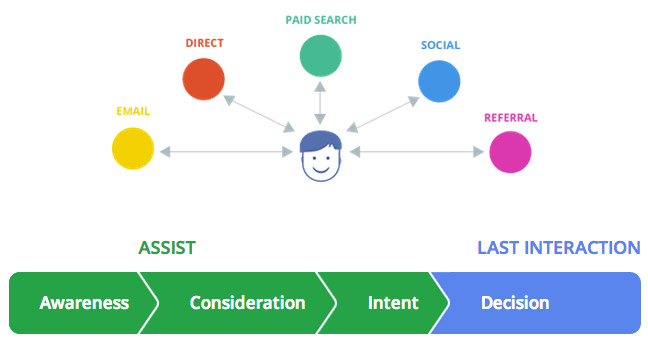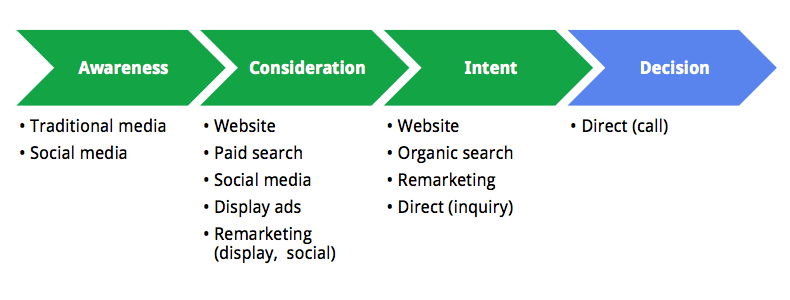Understanding your customers’ path to purchase
September 1, 2014

Google. Channels and points in the path to purchase – a simple yet useful tool in digital strategy.
When people can get all the info they need online, salespeople often don’t get to talk to prospective customers until they’re closer to buying. This might not be so bad if competition wasn’t a click away. Consumers are doing their own research, watching what their friends are doing on social media, and getting recommendations either directly or indirectly if their friends like/share/retweet brands or products.
So is it, “how do we interrupt everyone to peddle our wares?” or more like “where are they, what are they doing, and how do we help them solve their problem with our amazing product?”. Hint: it’s the long one, it’s always the long one (or C).
You can attract and influence prospects along this path by using an inbound approach targeting the channels that they’re using, like search, social media, and quality content on your own website. This is a more people-focused approach where marketing is like pre-customer service. Continuously evolving your tactics, including content strategy, is key.
Laying out a simple path to purchase can help you understand your customers’ online journey. To be effective you need a comprehensive understanding of your customers’ mindset and intent. I’ve found that starting out this way has had a big impact on my approach by providing focus to the big picture, regardless if you’re the digital person or not.
“Customer learning is happening all the time, and doesn’t coincide with your campaign calendar.”
Taking a people-first approach, the sample path below considers where people are and the kinds of content they consume on their journey, so you can come up with the right tactics at the right place and the right time. Display ads aren’t really considered an inbound tactic, but it can make sense in the right situation. Remarketing to stay top of mind can be a smart tactic as well.

Sample path to purchase with key channels at each stage, and a hint of tactics like remarketing.
The tables have turned, salespeople
People are more likely to come to you when they’re ready. By the time they do, they’re much farther down the path. The bigger the purchase the longer the journey can be — pricy, big decision stuff like travel, B2B sales, or higher education. In education, students (and their parents) research schools for weeks or months before making a decision. Today, B2B customers don’t talk to a salesperson until they’re over half way through the sales funnel. Also keep in mind that at least 50% of these customers will use more than one device in the span of their journey.
You may have demographics on your audience, but that doesn’t tell you the whole story about what they do online, what they care about, or how they make decisions. While this may be obvious to those of us familiar with digital tactics, it’s easier said than done for everybody. Here are some key things everyone should ensure their businesses do well.
Integrate digital into your marketing strategy
Don’t do that “ok now what about digital” thing after you’re half way through the creative process. The customer path to purchase is about behaviour, giving people the right content at the right place and time. Look at it this way and digital will fit where it should.
Have a content strategy
Part of a people-focused inbound approach is covering customers’ content needs on their journey. Like the point above, this has to be integrated into your strategy. If this isn’t part of your strategy then it’s time to work it in and figure out your workflow internally. Create, measure, refine. I know tables suck the fun out of pretty much everything, but this one’s a good basic framework for making sure your content is doing what it’s supposed to:
Have a continuous presence
We know that people are researching on their own time. In the education or tech industry for example, customers can take weeks to convert, and a conversion doesn’t even need to mean a sale. All the while they’re searching, looking at you on social media, and comparing to competitors. Your website should be a robot salesperson that’s geared toward the state of mind customers are in at various stages. Make it effortless for them. Understanding your audience will help you design the right user experience to move them down the path.
Don’t be afraid to experiment
Experimenting is fun. Or at least really feasible online. Don’t be afraid to be wrong, or to admit that you don’t know the answer to what ad or content or call to action will work best.
“I have not failed. I’ve just found 10,000 ways that won’t work.” – Thomas Edison
Have a hypothesis and test it. I’m wrong sometimes (I mean, uh, no I’m not), but the upside is that you find out what works and what doesn’t. And for me, I just have to quench my insatiable thirst for knowledge.
Subscribe via email for more diagram-y goodness and questionable grammar.
